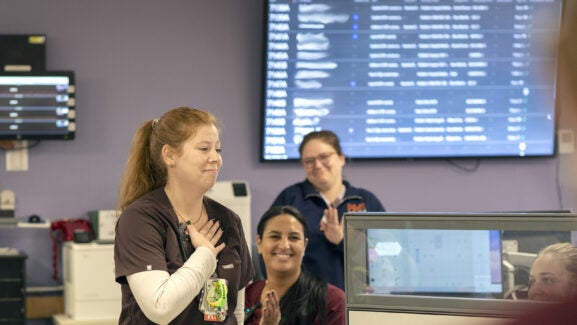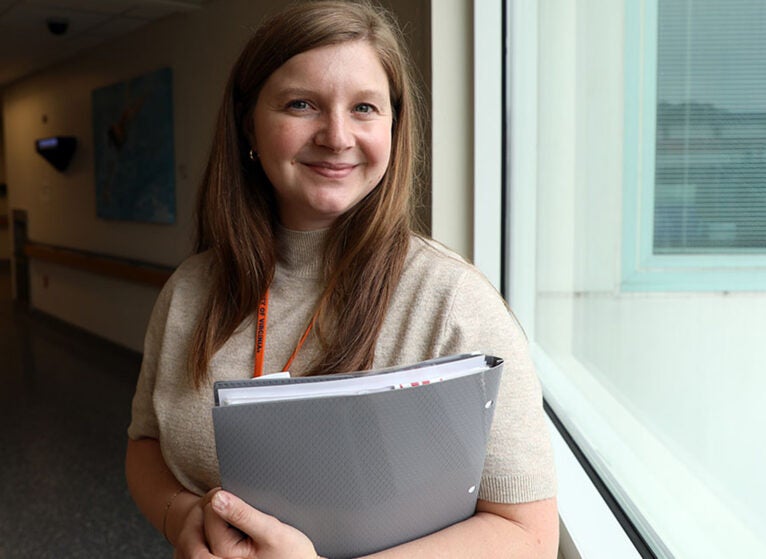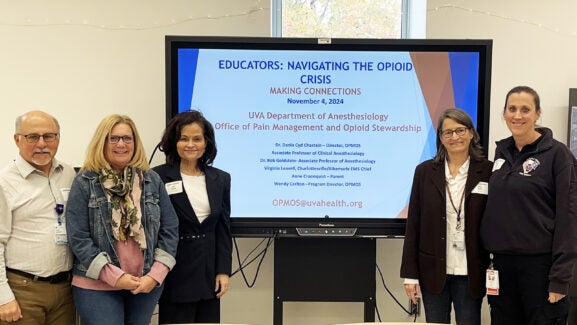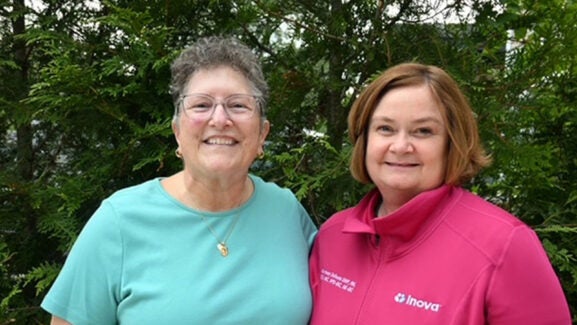

Kristin Long, now a nurse practitioner at UVA Health University Medical Center's acute floors, in a quiet moment outside the MICU.
Getting ICU Patients the 40 Winks They Need
By instituting a new policy to let patients sleep in the ICU between 12 and 4 a.m., acute care nurse practitioner and DNP graduate Kristin Long (DNP ’24) not only improved patient satisfaction and well-being, she educated her peers on why high-quality, undisturbed sleep is a key part of getting the sickest patients back on their feet and headed home. Sleep “prescriptions” are now part of health record charting, and a new owl graphic — a hospital “Do Not Disturb” card — will soon make the rounds.
Hospitals can be difficult places to get good rest.
While illness, discomfort, and pain can all come in the way of 40 winks, so, too, can the constant barrage of interruptions from well-meaning care providers who come calling round the clock to draw blood, check vitals, request labs, and re-position. In some cases, sleep deprivation can prolong ICU stays, cause emotional and physiological distress, and even increase the risk of death.
Long, a School of Nursing DNP graduate and a UVA Health acute care nurse practitioner, focused her final scholarly project on re-instituting Quiet At Night, a 12 to 4 a.m. protocol that nurse practitioners and physicians can prescribe for eligible patients that gained traction in the medical ICU, and, now, beyond it. She answered questions about her scholarship, just published in the Journal of Critical Care, as well as the importance of sleep, how she went about promoting it, and her affection for a new owl graphic that offers a “Do Not Disturb” message for patients who get the sleep promotion protocol on their hospital room doors.
“Patients expect to get sleep in a hospital, and they’re shocked that they don’t,” said Long. “Something simple like sleep, though, goes a long way.”
Why study sleep in particular?
When I was doing this project, I worked in the Medical ICU doing both day and night shifts. After every day shift, I’d always ask my patients, “How did you sleep last night?” Over and over, they’d tell me, “Oh, it was terrible, this was beeping, the nurses came in 10 times, I didn’t get any rest at all.” Often, they felt physically bad.
Obviously, doing a project was a requirement for school, but I also knew there were a few projects going on but nothing that incorporated the patients’ voices. That’s hard in the ICU, because a lot of our patients are intubated and sedated. I’ve always thought, though, that patients know their bodies best and, when possible, should be listened to.
Also, I wanted to make a lasting difference. I didn’t want to do my project and then leave. My colleague, [faculty member] Cheri Blevins, told me that the Society of Critical Care Medicine’s clinical guidelines have us assess pain, agitation, delirium, immobility, and sleep — we call these the PADIS guidelines — but mentioned that sleep is usually lumped in with delirium in practice, rather than a separate factor in and of itself. That piqued my interest.
How’d you start the project?
I checked out what the guidelines specific to sleep promotion were and stumbled upon a document called the “Quiet at Night” initiative, which had been rolled out before COVID but not actualized or updated since. I started highlighting things it advised and found a structure that provided a time frame where care providers intentionally minimized interactions with patients. The six- to eight-hour time frame it mentioned wouldn’t be feasible for an ICU, where we’re constantly checking on and assessing patients, but a four-hour time frame seemed possible for certain patients.
First, I had to figure out what inclusion factors to consider when selecting patients for the new protocol, and, because I wanted to keep patients’ voices involved, looked for and found a validated survey for them to take so they could offer details about the quality of sleep they got. I started thinking, too, about how to educate my interdisciplinary colleagues through presentations about why sleep is so important for patients in general, and for ICU patients in particular, the sickest of the sick, and then figure out ways to help them imagine what small changes we could bring about to maximize patients’ sleep, emphasizing that it was all for the patients’ well-being and would incorporate their voices.
How did your colleagues react?
I think it was well received, and the fact that I was actually asking people do to less, I didn’t think anyone would say no. It encouraged all of us to think about how to clump our work together so we could avoid bothering patients during certain time frames — in this case, between 12 and 4 a.m. Physicians had to get involved, and fix their orders, pharmacists had to adjust the timing of certain medications, and nurses were truly the gatekeepers of the process. They’d have to say to the physicians, “This medication is timed for here; can it be moved up two hours?” Everyone participated, everyone helped out.
What did patients say?
After everything was in place, I interviewed patients myself. I heard, “I could tell nurses were invested in my getting a good night’s sleep,” or, “Nurses hung towels over computer screens.” I even had a patient that I visited after being discharged from the ICU to another unit who said, “I slept so much better on your unit!” It was heartwarming.
Patients expect to get sleep in a hospital, and they’re shocked that they don’t, because they don’t realize that when you’re hooked up to four different machines, you’re not going to get rest. They don’t realize how the hospital works. Something simple like sleep, though, goes a long way.
You said you wanted to make a lasting impact. What’s happened since?
The sleep protocol has started to get better known as a process both inside and beyond the MICU and become part of the rounding checklist of items in more spaces at UVA Health. We created an EPIC order set, so a physician can actually just type in “sleep” and it pops up and enables them to set an order, one of a series of a la carte options. They can change the duration of the sleep “prescription” based on acuity: it might be for four, six, or even eight hours. While it’s mostly still being used in the MICU, where it’s thriving, I’m seeing a lot of providers outside that unit who are selecting the sleep order, as well. It’s gaining traction.
A coworker of mine drew an owl for me, which we used as a graphic to indicate that a patient was on sleep precautions and had an official order that prescribed rest. I’ve been talking with UVA Health’s marketing department, and we’re planning on making it an official sign, now that it’s an official order. That will help raise awareness. So will talking about it, which I’m doing a lot of.
I also see more conversations with our local shared governance structure and hope I can meet with colleagues across the hospital to explain what the initiative was, how to implement it, what it looks like for providers to place “sleep orders,” and what it means for unit nurses.
What’s interesting is that, when I was a DNP student, I implemented the protocols and project as a nurse. Now that I’m a nurse practitioner, I see it from the provider perspective and consider it a strength of being an NP.
I’m also having conversations, too, about standardizing rounding checklists across all ICUs at UVA, so the sleep protocols and prescriptions are a standardized, routine part of our workflows. What I’d like to happen now is for EPIC to, if a provider said they wanted to do a sleep promoting plan, automatically change the other orders, rather than having the nurses scramble to make those adjustments.
Your work was just published in the Journal of Critical Care. What’s next?
Publishing was one of those things that I didn’t think would ever happen to me. As DNP students, we’re required to submit our projects for publication, and when I didn’t hear back for a long while, I assumed the journal had taken a pass. But publishing is such a long process.
I feel fortunate to have the publication, and thankful for the guidance I’ve had from Drs. Hundt and Wiencek, who kept giving me insight along the way. Since the paper came out in April, I’ve been getting emails, having conversations with medical directors and marketing. People are asking, “How can we bring this to my floor?”
It’s really re-sparked my interest. I really wanted to do this for the patients, and I did.
Latest News




